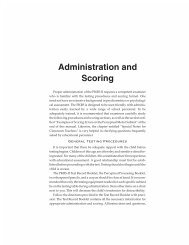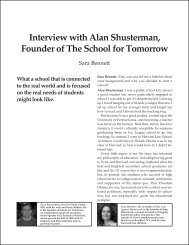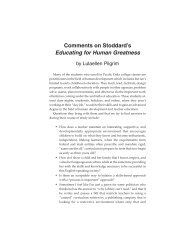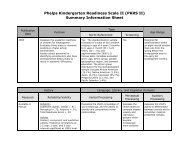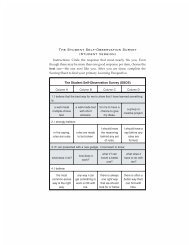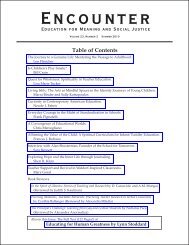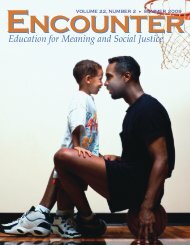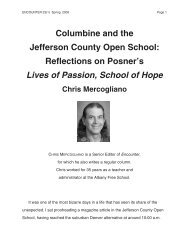Jane Goodall - Great Ideas in Education
Jane Goodall - Great Ideas in Education
Jane Goodall - Great Ideas in Education
You also want an ePaper? Increase the reach of your titles
YUMPU automatically turns print PDFs into web optimized ePapers that Google loves.
30 ENCOUNTER: <strong>Education</strong> for Mean<strong>in</strong>g and Social Justice<br />
Cognitive Development<br />
Confident she had unpacked the self-organiz<strong>in</strong>g<br />
nature of motor development, Thelen turned her attention<br />
to the cognitive doma<strong>in</strong>. She began by revisit<strong>in</strong>g<br />
the work of certa<strong>in</strong> explorers from the previous<br />
generation of developmental psychologists — Jean<br />
Piaget, Kurt Lew<strong>in</strong>, and Eleanor and James Gibson,<br />
among others — who had already begun to break<br />
away from the old-paradigm view that <strong>in</strong>telligence is<br />
exclusively a mental th<strong>in</strong>g and that learn<strong>in</strong>g is the passive<br />
absorption and storage of <strong>in</strong>formation. Piaget,<br />
Lew<strong>in</strong>, and the Gibsons were all holistic th<strong>in</strong>kers who<br />
viewed cognitive development as an active and <strong>in</strong>teractive<br />
construction process that <strong>in</strong>volves the body as<br />
well as the m<strong>in</strong>d. For them, development became the<br />
study of all of the means by which children learn to<br />
adapt successfully to the changes and challenges <strong>in</strong><br />
their respective environments.<br />
Thelen proceeded to weave <strong>in</strong>to this new orientation<br />
the recent neuroscientific discoveries that were<br />
unavailable to Piaget and the others. She drew heavily<br />
upon the research of the aforementioned Gerald<br />
Edelman, one of whose pr<strong>in</strong>cipal areas of <strong>in</strong>vestigation<br />
is the neural basis of cognitive development, and<br />
beyond that, of consciousness as a whole. Like the<br />
Gibsons before him, Edelman believes the process beg<strong>in</strong>s<br />
with perception. Whenever <strong>in</strong>fants see, hear,<br />
smell, or touch someth<strong>in</strong>g, their bra<strong>in</strong>s construct actual<br />
neural maps that emerge spontaneously from the<br />
chaotic <strong>in</strong>teraction of large groups of neurons <strong>in</strong> the<br />
bra<strong>in</strong>. There is no localized control center responsible<br />
for the mapp<strong>in</strong>g; rather the neural patterns that underlie<br />
perception are self-organiz<strong>in</strong>g. Moreover, the<br />
patterns are “plastic,” mean<strong>in</strong>g that their shape<br />
readily alters <strong>in</strong> synch with shifts <strong>in</strong> experience. Then,<br />
over time, the maps overlap and reassemble as babies<br />
beg<strong>in</strong> to sort their perceptions <strong>in</strong>to the categories that<br />
will become the basis of their concrete knowledge<br />
about the world. Categorization, too, is a self-organiz<strong>in</strong>g<br />
process (Thelen & Smith 1994, 136).<br />
Edelman’s mapp<strong>in</strong>g theory stands <strong>in</strong> stark contrast<br />
to the old-paradigm assumption that the categories<br />
which give order to our th<strong>in</strong>k<strong>in</strong>g — space,<br />
time, shape, color, causation, and so on — are fixed<br />
and have an <strong>in</strong>dependent existence like Newton’s<br />
laws. Accord<strong>in</strong>g to Edelman, there are no predeterm<strong>in</strong>ed<br />
categories because they are constantly chang<strong>in</strong>g<br />
and comb<strong>in</strong><strong>in</strong>g <strong>in</strong> orig<strong>in</strong>al ways depend<strong>in</strong>g on<br />
the context, history, and current state of the<br />
perceiver. Aga<strong>in</strong>, broad evolutionary parameters do<br />
exist; however, each <strong>in</strong>dividual m<strong>in</strong>d is uniquely<br />
shaped by experience and the dynamics of self-organization.<br />
Thelen, as did Piaget, ref<strong>in</strong>ed her <strong>in</strong>sights <strong>in</strong>to the<br />
basic nature of cognition by zoom<strong>in</strong>g <strong>in</strong> on the world<br />
of <strong>in</strong>fants. She started out by <strong>in</strong>vestigat<strong>in</strong>g babies’<br />
early efforts to reach and search because these<br />
goal-oriented behaviors play a fundamental role <strong>in</strong><br />
all subsequent perceptual-motor and rational-symbolic<br />
learn<strong>in</strong>g. Like Piaget — and <strong>in</strong> some <strong>in</strong>stances<br />
repeat<strong>in</strong>g certa<strong>in</strong> of his iconic experiments — she<br />
was able to show how cognitive development<br />
self-organizes <strong>in</strong> exactly the same manner as<br />
sensorimotor development, driven by a child’s <strong>in</strong>tr<strong>in</strong>sic<br />
motivation to explore and seek out novel and<br />
challeng<strong>in</strong>g experiences. Interest<strong>in</strong>gly, Piaget (1952,<br />
407-410) valued kids’ self-<strong>in</strong>itiated, self-directed discoveries<br />
so highly that he sometimes referred to<br />
them by the French word aliment, mean<strong>in</strong>g food.<br />
Along the way, Thelen was able to root out the<br />
Newtonian vestiges <strong>in</strong> Piaget’s th<strong>in</strong>k<strong>in</strong>g, the most<br />
prom<strong>in</strong>ent among them the idea that there is a universal<br />
template for cognitive development, which<br />
occurs <strong>in</strong> an orderly succession of stages. Her meticulous,<br />
high-magnification observations clearly<br />
showed that because every child’s <strong>in</strong>ner make-up<br />
and outer circumstances are unique, and because development<br />
emerges out of the dynamic <strong>in</strong>teraction<br />
between the two, the developmental process isn’t<br />
uniform at all. To use Thelen’s metaphor, development<br />
is “not a march<strong>in</strong>g band; it’s a teem<strong>in</strong>g mob.”<br />
(Thelen & Smith 1994, 21-22).<br />
Thanks to Esther Thelen and her associates, we are<br />
presented with an entirely new model whereby development<br />
self-assembles <strong>in</strong> context and <strong>in</strong> the moment,<br />
with the direction always com<strong>in</strong>g from with<strong>in</strong>. Or <strong>in</strong><br />
her words, “Development can happen <strong>in</strong> an organized<br />
way all on its own with neither an external<br />
teacher nor a bluepr<strong>in</strong>t for the developmental outcome.”<br />
(Thelen & Smith 1994, 170). Beg<strong>in</strong>n<strong>in</strong>g from<br />
the moment we are born it is a cycle of challenge, exploration,<br />
discovery, and new challenge that cont<strong>in</strong>ues<br />
until the day we die (Thelen & Smith 1994,<br />
323-325). And aga<strong>in</strong>, the process is self-motivated and




